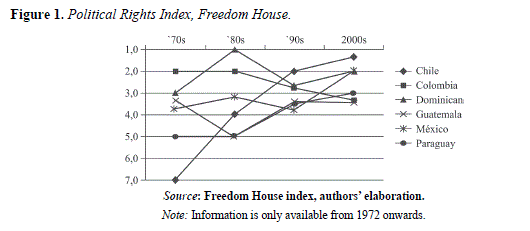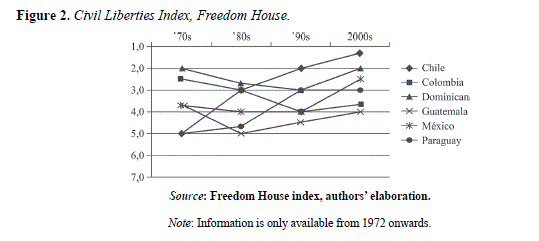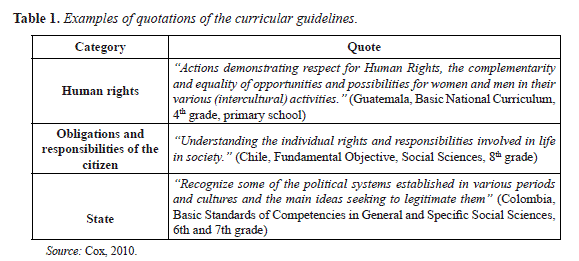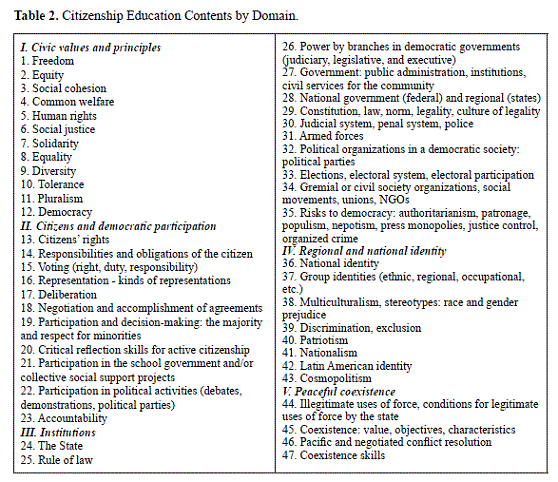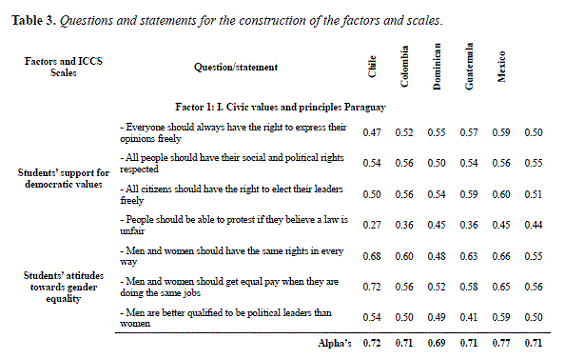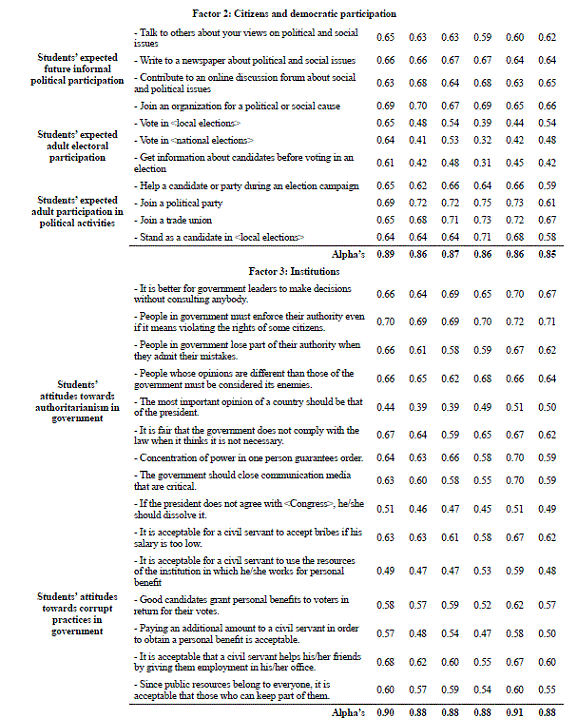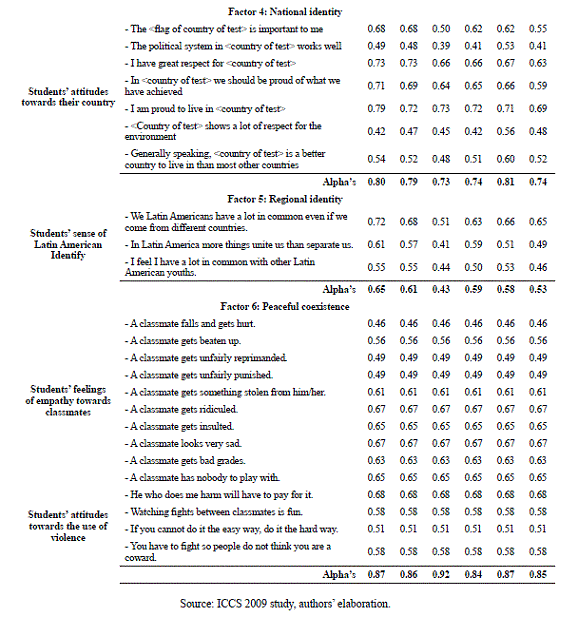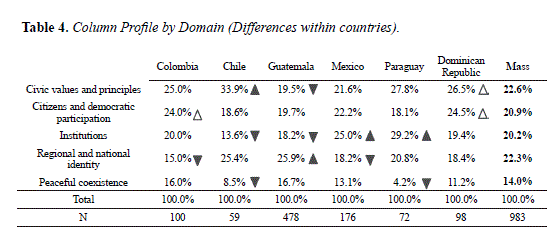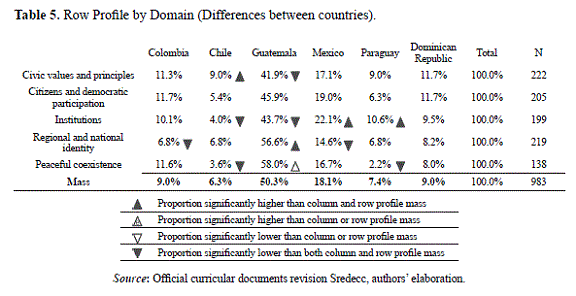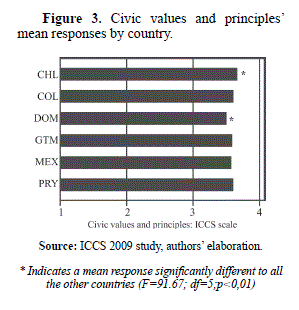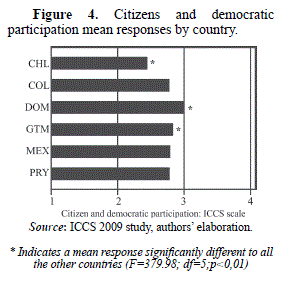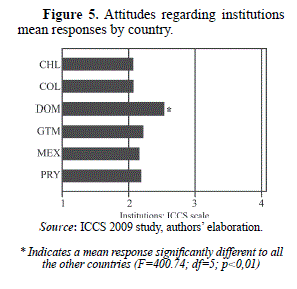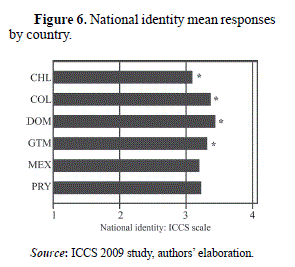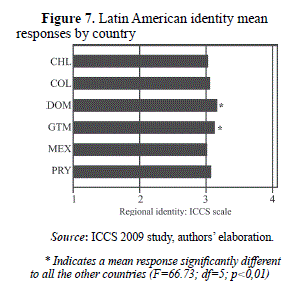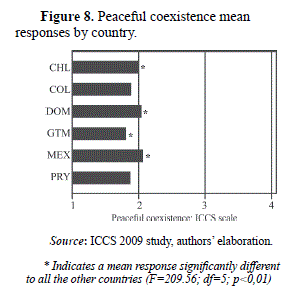Serviços Personalizados
Journal
Artigo
Indicadores
-
 Citado por SciELO
Citado por SciELO -
 Acessos
Acessos
Links relacionados
-
 Citado por Google
Citado por Google -
 Similares em
SciELO
Similares em
SciELO -
 Similares em Google
Similares em Google
Compartilhar
Revista Latinoamericana de Ciencias Sociales, Niñez y Juventud
versão impressa ISSN 1692-715X
Rev.latinoam.cienc.soc.niñez juv vol.13 no.2 Manizales jul./dez. 2015
https://doi.org/10.11600/1692715x.13243280814
Segunda sección: Estudios e Investigaciones
DOI: http://dx.doi.org/10.11600/1692715x.13243280814
Curricular guidelines and citizenship attitudes in Latin American students: a comparative analysis*
Currículos oficiales y actitudes ciudadanas de estudiantes en América Latina: Un análisis comparativo
Currículos oficiais e atitudes cidadãs de estudantes na América Latina: Uma análise comparativa
Martín Bascopé1, Macarena Bonhomme2, Cristián Cox3, Juan Carlos Castillom4, Daniel Miranda5
1 Profesor Pontificia Universidad Católica de Chile, Chile. Sociologist and MSc in Economics at Pontificia Universidad Católica de Chile, Professor at the Pontificia Universidad Católica de Chile in campus Villarrica and Research Associate at the Center for Research on Educational Policy and Practice (Ceppe). E-mail: mbascope@uc.cl
2 Investigadora Pontificia Universidad Católica de Chile, Chile.Sociologist at Pontificia Universidad Católica de Chile, MSc in Culture and Society at the London School of Economics, PhD student in Sociology at Goldsmiths, University of London, Head of Project at Pontificia Universidad Católica de Chile. E-mail: mbonhomm@uc.cl
3 Pontificia Universidad Católica de Chile, Chile. Sociologist at Pontificia Universidad Católica de Chile, PhD in Sociology at University of London. Dean of the Faculty of Education at the Pontificia Universidad Católica de Chile, and Researcher at the Center for Research on Educational Policy and Practice (Ceppe). Consultant for different international organizations, such as the IEA and Sredecc. E-mail: ccoxn@uc.cl
4 Profesor Pontificia Universidad Católica de Chile, Chile. Psychologist at Pontificia Universidad Católica de Valparaíso, PhD in Sociology at Humboldt University. Professor at the Institute of Sociology, Pontificia Universidad Católica de Chile. Deputy Director at the Centre for Social Conflict and Cohesion Studies (COES). E-mail: jcastillov@uc.cl
5 Investigador Pontificia Universidad Católica de Chile, Chile. Psychologist at Universidad de Talca, MSc in Psychology at Pontificia Universidad Católica de Chile. PhD student in Sociology at Pontificia Universidad Católica de Chile. Researcher at Pontificia Universidad Católica de Chile. E-mail: damiran1@uc.cl
Artículo recibido en julio 29 de 2014; artículo aceptado en octubre 28 de 2014 (Eds.)
Abstract (analytical):
Curricular guidelines have become progressively relevant for educating future active citizens. In such a context, it becomes crucial to explore the relationship between the curricular guidelines and how citizenship education is currently acquired by students in Latin American countries. Therefore, the aim of this paper is to comparatively evaluate the institutional view of citizenship expressed in each curriculum and students’ attitudes on civic issues. The exploratory factor analysis and curricular descriptive statistical analysis are based in two valuable and complementary sources, respectively: The Latin American module of the International Civic and Citizenship Study (ICCS) and the Regional System of Citizenship Skills (Sredecc). By making a systematic comparison of both sources, this study reveals that several curricular aspects are consistent with students’ citizenship attitudes and beliefs, and suggests some guidelines for improving and expanding citizenship education in Latin America, considering the importance of education for the formation of an active citizenship.
Key words: politic education, adolescence, Latin America (Unesco Social Sciences Thesaurus).
Authors key words: citizenship education, curriculum, civic knowledge, political socialization, civic attitudes, curricular comparison.
Resumen (analítico):
Los currículos son progresivamente relevantes para educar futuros ciudadanos activos. En este contexto, se vuelve fundamental explorar la relación entre las directrices curriculares y cómo la educación ciudadana es efectivamente alcanzada por los estudiantes en países Latinoamericanos. Por ello este artículo tiene por objetivo evaluar comparativamente la visión institucional expresada en cada currículum y las perspectivas de los estudiantes sobre asuntos ciudadanos. El análisis factorial exploratorio y el análisis estadístico descriptivo curricular se basan en dos fuentes valiosas y complementarias, respectivamente: El Estudio Internacional de Educación Cívica y Ciudadana (ICCS) y el Sistema Regional de Competencias de Ciudadanía (Sredecc). Luego de una comparación sistemática de ambas fuentes este estudio revela que varios aspectos curriculares son coherentes con las actitudes y creencias de los estudiantes, y sugiere pautas para mejorar y expandir la educación ciudadana en América Latina, considerando la importancia de esta para la formación de una ciudadanía activa.
Palabras clave: educación política, adolescencia, Latinoamérica (Tesauro de Ciencias Sociales de la Unesco).
Palabras clave autores: educación ciudadana, currículos, conocimiento cívico, socialización política, actitudes cívicas, comparación curricular.
Resumo (analítico):
Os currículos são cada vez mais relevantes para educar futuros cidadãos ativos. Neste contexto, torna-se essencial explorar a relação entre as diretrizes curriculares e a forma como a educação para a cidadania é efetivamente apreendida por estudantes de países latinoamericanos. Portanto, este artigo tem como objetivo avaliar a visão institucional expressa em cada currículo e as perspectivas dos alunos sobre questões cidadãs. A análise fatorial exploratória e a análise estatística descritiva curricular é baseada em duas fontes valiosas e complementares: O Estudo Internacional de Educação Cívica e Cidadã (ICCS) e do Sistema Regional de Competências Cidadãs (Sredecc). Depois de uma comparação sistemática das duas fontes foi constatado que vários aspectos curriculares são consistentes com as atitudes e crenças dos alunos, e sugerem diretrizes para a melhoria e expansão da educação dos cidadãos na América Latina, considerando-se a importância desta para a formação de uma cidadania ativa.
Palavras-chave: educação política, adolescência, América Latina (Tesauro de Ciências Sociais da Unesco).
Palavras-chave autores: educação cidadã, currículos, conhecimento cívico, socialização política, atitudes cívicas, comparação curricular.
1. Introduction
Citizenship education has become an increasingly salient aspect of governments’ agendas for student formation because it not only provides civic skills and knowledge, but also promotes political participation (Cho & McLeod, 2007, Cohen & Chaffee, 2012, Delli- Carpini, 2009, Galston, 2001a, 2004a, McAllister, 1998a, Owen, Soule & Chalif, 2011a, Torney-Purta, 2010). School is a foundational experience for children in the public field, providing a space to interact with others outside the family (Crick, 2003, Peña, 2007). In this context, the official curriculum on citizenship education in schools is fundamental for ensuring that specific content related to citizenship, nation-state, and region can be transmitted to the students effectively, thereby developing politically engaged future citizens. Furthermore, the role of civic education acquires renewed relevance in the context of social, political, economic, and demographic change. As the boundaries have become more diffuse between countries with increasingly fluid migration, the concept of citizenship has become global as well, such that the boundaries of identity are not only national, but also transnational or supranational (Keating, Hinderliter & Philippou, 2009). Therefore, given constant societal evolution and change due to global trends and/or socio-political structure, citizenship education also undergoes profound changes (Kerr, 1999). This makes it particularly interesting to scholars when considered within the various contexts of Latin American countries.
A curricular comparison is helpful in outlining how countries from the same region, which share a language and have a similar political history, have diverged or aligned in their development of the concept of citizenship, often emphasizing certain contents rather than others. Several scholars have analyzed the curricula of the European region focusing on the (non-) coverage of European citizenship, whereas others have compared developed countries with similar political and socioeconomic profiles (Keating et al., 2009, Torney-Purta & Barber, 2004, Torney-Purta, 2010). A curricular comparison not only highlights different approaches to citizenship education and the concept of citizenship itself (Kerr, 1999), but also shows the common challenges that similar countries face (Hughes, Print & Sears, 2009). Thus, the discussion of potential approaches to enhancing citizenship education is enriched by considering the experiences of neighboring countries (Kerr, 1999). As Kerr (1999) argues, even though an ideal curriculum could emerge from the holistic perspective offered through such a comparison, this could not then simply be transplanted to another country without taking into account its particular historical, political, social, and economic context. In effect, Hughes et al. (2009) concluded that even when countries share characteristics in their citizenship education curricula, the effects of these programs can be completely different. In this line of research, however, there is scarce evidence of comparative or in-depth curricular analysis of citizenship education focused on Latin American countries. The present study aims to fill this gap to achieve a more holistic picture of how citizenship is understood and meant to be taught in the schools by each country analyzed.
Along with the curricular comparison, we also collected data regarding students’ attitudes towards citizenship, so the aim of this study is to contrast two different sources of information regarding citizenship education in Latin America: curricular guidelines and students’ civic attitudes. We revised the official national documents of the respective Ministries of Education for analyzing curricular guidelines, and the results of the International Civic and Citizenship Education study (ICCS 2009) for analyzing the students’ attitudes on citizenship. The present article will show which aspects were covered or left uncovered in official curricula, comparing both within and between countries; and it will also contrast curricular results with students’ attitudes and expectations, crystallized on the questionnaires administered alongside the ICCS international test to compare only between countries. Thus, the results will identify the main aspects that policymakers and schools should cover to both improve citizenship attitudes and to expand the current official curriculum to encompass a more complete range of contents and teaching objectives. This study also contributes to the literature on citizenship education in Latin American countries, identifying the most relevant citizenship contents, and the main gaps expressed both in the official curriculum and through student’s perspectives. It is worth noting that the intention of the present study is not to find a causal relationship between the curricular guidelines and the students’ perceptions gathered in the international evaluation, but to show the absences and emphases of citizenship education in Latin American countries from two different perspectives: the institutional -the representation of the ‘ideal citizen’ each government aims to achieve through the curriculum- and the students -the effective citizenship attitudes and beliefs of the ‘future citizens’.
Democracy and citizenship education
Any democratic system is sustained through political participation because it is the main mechanism to ensure that individuals communicate their interests and needs, and pressure governments to act in response (Schlozman, Verba & Brady, 1999). Although political knowledge is acquired throughout life, its basis is obtained through political socialization in school, which prepares students to be future citizens (Geboers, Geijsel, Admiraal & Dam, 2013). In fact, one of the assumptions of political socialization is that a good citizen does not necessarily appear spontaneously, but rather, early socialization within the family, and particularly at school, should aim to provide the tools that allow future citizens to become successfully involved in the political system.
Citizenship education in this sense enables students’ acquisition of civic knowledge and skills to participate in the future (Quintelier, 2010). Several studies -using data from the studies on citizenship education of the International Association for the Evaluation of Educational Achievement (IEA), such as the Civic Education Study (Cived) in 1999 and the International Civic and Citizenship Education study (ICCS) in 2009 -have demonstrated that civic knowledge influences political participation in young populations (Galston, 2001b, 2004b, Isac, Maslowski, Creemers & van der Werf, 2013, McAllister, 1998b, Owen et al. 2011a, Quintelier, 2010, Torney-Purta, Lehmann, Oswald & Schulz, 2001). The higher the students’ civic knowledge scores, the more likely they were to participate politically in the future (e.g., vote in elections) (Isac et al., 2013, Torney-Purta et al., 2001, Wilkenfeld, 2009).
The emphasis on the school’s role was commonly related to the transmission of civic knowledge based on the premise that knowing about the functioning of the political system is relevant for the formation of an active citizenry (Levinson, 2010, Owen et al., 2011a, Quintelier, 2010, Torney-Purta et al., 2001, Wilkenfeld, 2009). Nonetheless, recent evidence has highlighted the importance of ‘how’ civic knowledge is transmitted rather than only ‘what’ is transmitted by schools. In this sense, some scholars argue that exposure to a democratic environment in the school (Alivernini & Manganelli, 2011, Campbell, 2007, 2008, Ichilov, 2003, 2007, Martens & Gainous, 2012, Quintelier & Hooghe, 2012, Solhaug, 2006, Torney-Purta, 2010) and active learning strategies (Biesta, Lawy, & Kelly, 2009, Hart, Donnelly, Youniss & Atkins, 2007, Haste, 2010, Hooghe & Dassonneville, 2011, Jerome, 2012, Misa, Anderson & Yamamura, 2005, Owen & Soule, 2010, Quintelier, 2010, Torney- Purta, 2002, 2010, Youniss, 2012) can be as (or even more) important as the transmission of civic knowledge when promoting civic engagement in the future. Accordingly, Ibrahim (2005) argues that it is critical to examine the contents of citizenship education in the official curriculum to analyze whether or not they can be effectively used to increase participation in school and prepare students for future political engagement and participation.
Citizenship education: Civic and civil
This study distinguishes two aspects of citizenship education and participation: civic and civil. The civic dimension attempts to cover those aspects linked to formal political institutions, such as the election of representatives and membership in formal political organizations, e.g., political parties.
In turn, the civil dimension is concerned with informal institutions and activities that imply interaction with local communities. Both aspects are part of a wider concept of citizenship education:
"Citizenship education focuses on knowledge and understanding and on opportunities for participation and engagement in both civic and civil society. It is concerned with the wider range of ways that citizens use to interact with and shape their communities (including schools) and societies." (Schulz, Ainley, Fraillon, Kerr & Losito, 2010, p. 22)
It has been noted that both civic and civil participation are related to one another and are a necessary condition for the functioning of the democratic system: "Civil associations contribute to the effectiveness and stability of democratic government, it is argued, both because of their ‘internal’ effects on individual members and because of their ‘external’ effects on the wider polity" (Putnam, 1993, p. 89).
Curriculum and citizenship education
The citizenship education field is undergoing a transition from traditional civic education to modern citizenship education (Eurydice, 2005, Suárez, 2007, 2008). In other words, there is a shift from only civic focus toward a concept of citizenship (Cox, Jaramillo & Reimers, 2005, Kerr, 1999, Schulz et al., 2010) that encompasses a wider spectrum of civil and civic elements. This conceptualization of citizenship education contains not only a nation-bounded or institutional perspective of civic education, but also cross-national values. Furthermore, there is more recognition of the need to create abilities rather than just content-based knowledge about civic elements (McCowan, 2009).
From a national to a supranational curriculum
Western societies during the eighteenth and nineteenth centuries, in their effort to legitimize the nation-state, emphasized a ‘sense of nation’ in the school curriculum, teaching only their national culture, institutions, and history while ignoring other cultures and societies (Keating et al., 2009, p. 146). However, globalization and new technologies have impacted this traditional relationship between citizenship education and the nation-state, providing alternative ways to identify and participate that transcend the nation-state focus (Keating et al., 2009). For example, according to Keating et al. (2009), the official curricula of some European countries show an official understanding of citizenship that is purposely shaped to consider new contexts, and understand the curricula as a key element in the articulation of each nation’s aim in citizenship education. Therefore, in the last few decades, the common notion of citizen has changed. Citizenship education needs to take into consideration the political, social, economic, and demographic changes loosely defined in the term ‘globalization’ (Fischman & Haas, 2012). Worldwide citizenship education is becoming global, which is clearly exemplified in the cross-national programs and policies conducted by the Organization for Economic Co-operation and Development (Oecd), such as the Program for International Student Assessment (Pisa), and by the United Nations Educational, Scientific and Cultural Organization (Unesco), such as the General Agreement on Trade in Services (Gats), both of which have taken a transnational perspective on education (Keating et al., 2009).
Consequently, according to Kerr (1999), the challenges that countries face currently are similar. Today, citizenship education has a common list of values and cross-national content that educational systems must be prepared to address. These challenges include multiculturalism, pluralism, cultural heritage, diversity, tolerance, social cohesion, collective and individual rights and responsibilities, social justice, national identity, and freedom, among others (Kerr, 1999). How countries tackle the concept of citizenship and citizenship education, however, varies according to their historical traditions, geographical position, socio-political structure, economic system, and global trends (Kerr, 1999). For example, the focus on citizenship education acquired by European countries’ curricula establishes a European dimension related to supranational identity and policies (Keating et al., 2009). These factors influence the organization of the government, as Kerr (1999) showed, which in turn affects certain structural characteristics of education such as its organization, values, aims, and funding. As Ibrahim (2005) asserted, it is crucial to have global citizenship as a framework in the countries’ curricula; this allows for a more inclusive kind of citizenship that can encompass global issues and move individuals (especially those with power and resources) to act responsibly. In this sense, a complete framework regarding citizenship contents at school was needed to be considered for this study.
Before presenting the data and research methods, a brief review of the political context of Latin American countries becomes necessary as a framework for interpreting the results, and most importantly, for understanding the relationship between the national representation of the ‘ideal citizen’ and the real attitudes and beliefs of students who are taught by those guidelines on citizenship education.
Latin American political context
Even though Latin American countries share a language, religion, and a similar colonization process, the existent literature and indices compiled by international institutions show some diversity in terms of culture, political history and participation patterns (civil and civic) among these six countries (Hartlyn & Valenzuela, 1997). The main differences between them emerge in their respective processes of political development. During the twentieth century, this region faced several types of interruptions, which called their democracies into question. Thus these interruptions prevent us from considering them as sharing the same experiences. Nonetheless all these different interventions have often restricted opportunities for civic and civil participation.
Latin America’s fledgling democracies make this region an interesting case for comparing the different ways each country has developed its citizenship education guidelines.
Since the early twentieth century, various attempts to empower representative regimes have been interrupted by military dictatorships, political unrest, civil wars, and human rights violations throughout the region (Hartlyn & Valenzuela, 1997). Political instability, particularly in the case of Central American countries, emerged due to external pressure, which triggered wars and invasions. In South American countries, instability arose from pressure from landholder elites reacting to government policies that promoted greater political participation among citizens or that undertook land reforms (Hartlyn & Valenzuela, 1997). This study considers two Central American countries (the Dominican Republic and Guatemala), three South American countries (Colombia, Chile and Paraguay), and Mexico.
Particularly in the post-dictatorship eras, efforts have been focused on voter turnout in elections to strengthen democracy because electoral participation is democracy’s mandatory minimum (Munck, 2011). Nonetheless, the quality of their democracies has been questioned. Democratic quality can be measured by evaluating key dimensions, including participation in events like elections and decision-making processes regarding policies implemented by the government (Diamond & Morlino, 2004), and, to a lesser extent, by participation and connection with the community.
The political situations of the six countries reviewed here are represented by a set of indicators developed by Freedom House on ‘Political Rights’ (see Figure 1) and ‘Civil Liberties’ (see Figure 2). This analysis consists of calculated average indices for the years in which elections occurred in each decade. These indices range from one to seven, where one indicates a high degree of rights and liberties, and seven indicates their absence. While some countries have been gradually increasing in political stability (Chile, Mexico, and the Dominican Republic) the others (Colombia, Guatemala, and Paraguay) have maintained a score of more than three in both indices, which places them as ‘partly free’ because their political systems do not protect certain political rights and civil liberties.1
Considering the diversity in democratic and political development, it was vital to explore how each country had crystallized its historical and political background in their official curricula, and to determine what kind of citizen each aimed to educate. Furthermore, the comparative perspective allowed us to analyze the differences between the curricular guidelines and students’ attitudes regarding citizenship among these countries to discover the extent to which the evidence obtained through the international test reflected the purposes encapsulated in each official curriculum.
2. Data and research methods
This study combined two data sources. The first was a database containing direct quotes from the six official curricula, which defined the mandatory contents and objectives in citizenship education. This database was created in the context of the project ‘Sistema Regional de Competencias Ciudadanas’ (Sredecc -Regional System of Citizenship Skills), sponsored by the Inter-American Development Bank (IDB). This program was created in the context of the ICCS study, under the supervision of the six Ministries of Education, with the intention of expanding the knowledge and data sources regarding citizenship education. The database consisted of 1,542 quotes, containing the full text of contents and objectives present in the reviewed documents (983 primary and 559 secondary quotes).2
The second data source was information regarding eighth-grade students’ attitudes compiled by the ICCS study for six Latin American countries (Chile, Colombia, the Dominican Republic, Guatemala, Mexico, and Paraguay), which involved a stratified sampling of 29,962 students selected from 1,027 schools (Schulz et. al., 2010).
The dimensions and contents used for the revision of the national curricular documents were based on the framework used for the international evaluations regarding these issues, with particular emphasis on Latin America (Cox, 2010). This framework considered five dimensions and 47 types of content regarding citizenship education. The framework used to define the principal domains for categorizing and extracting citations from the official curricula was the same one used to build the IEA Civic Education Study Cived (1999) and the ICCS (2009). This study also considered the Latin American module of the ICCS evaluation (Schulz & Brese, 2008, Schulz, Fraillon & Ainley, 2011, Torney-Purta, Schwille & Amadeo, 1999). In this context, we considered five dimensions: 1) civic values and principles, 2) citizens and democratic participation, 3) institutions, 4) regional and national identity, and 5) peaceful coexistence. Each dimension contains a set of types of content.3 These five dimensions emerged as a result of a previous study conducted by Cristián Cox (2010), which compared the curricular guidelines of the six Latin American countries presented above. The present study made a more concise analysis of the curriculum to incorporate the students’ results while maintaining this original framework. In this case, the unit of analysis was the quote, or a complete definition (textual or paraphrased) of the contents or objectives of the curriculum, as can be observed in the examples of table 1 below.
The citation focused on a "unit of meaning", often address more than one of the categories of the analytical matrix, which implies that the same citation may be counted more than once.4
The analysis that follows describes citizenship thematic priorities both per country and in general, based on a list of domains and contents established by Cox’s (2010) framework, leaving aside the specific meanings that each quote could have in each curriculum. Furthermore, in this type of measurement it is not possible to discriminate in terms of the ‘positional value’ of the citation, which would be important to identify in future research.5
For the curricular analysis, tables with a proportion of quotes were used to show the significant differences between and within countries, comparing these proportions with the ‘mass proportion’ that aggregates the quotes of all countries/dimensions. The same analysis could be carried out with the complete list of contents within each domain (47 contents; see table 2), but the results would be particularly challenging to read and summarize. The nature of this kind of analysis came from the profile tables used in correspondence analysis, a method widely used to analyze categorical data (Benzécri, 1979, 1992, Greenacre, 2007, Lebart, Morineau & Tabard, 1977, Roux & Rouanet, 2004).
Five factors regarding students’ attitudes were constructed to cover the dimensions used for the curricular analysis. We used 65 questions from the ICCS student questionnaire and the Latin American module to construct these factors; these questions were the same as those that the ICCS team used to construct twelve scales included in their report (Schulz, Friedman & Ainley, 2011).
Categories retrieved from Cox (2010), made in the context of the ICCS evaluation, the framework of the regional model Sredecc, and the primary and secondary official documents from Colombia, Chile, Guatemala, México, Paraguay, and the Dominican Republic Ministries of Education.
All statements used for the construction of the ICCS scales and factors of this study were multiple-choice questions (level of agreement, expected behavior, and frequencies). Table 3 is useful for a proper understanding of each factor’s content.
The analysis was conducted using different items that originally belonged to different scales in the conceptualization of the ICCS study. Nevertheless, the factor analysis reduced a group of scales to only one dimension to simplify the analysis, which showed only six factors according to five dimensions of the curricular analysis. The factor analysis was developed using Stata (Version 12) [Software] (2011) through the principal axis factor technique. Table 3 presents the information about the factor loadings on each item, analyzed by country, to ensure that item aggrupation was valid for each country; it also allowed comparability of the scales between countries. After this analysis, some of the items a priori considered for the dimensions were dropped because their loadings were too low to fit into the factor (<0.3). Upon completion of the factor analysis, an internal consistency reliability analysis for each factor was conducted by calculating Cronbach’s alpha; which serves as complementary information about the internal consistency of the measures (also shown in Table 3).6
The results regarding students’ attitudes and participation in each country were analyzed as follows: first the exploratory factor analysis was calculated using principal axis methods, resulting in six factors, one for each domain of table 2. The exception was "Regional and national identity," where two factors resulted: one for national and the other for regional identity. Then, six graphs were constructed to compare the mean of student responses on each factor, indicating the differences between countries.
The scores obtained ranged from 1 to 4, resulting from the Likert scale of the items. For the interpretation of the graphs, an Analysis of Variance (Anova) was calculated to look for significant differences between the main responses of each country. The main results of both analyses (curricular and attitudinal) were contrasted, generating grounds for discussion from two perspectives: the institutional, represented in the curriculum coverage, and the students’ perspectives, collected in the ICCS questionnaires.
3. Results
Curricular comparison
Curricular guidelines: comparison between and within countries
First, the proportion of quotes within and between countries was calculated, comparing it with the "mass proportion" (considering the total amount of quotes of the region). This kind of analysis shows the different emphasis given to each dimension by these Latin American countries. This was in order to give a larger picture of the curricular guidelines of citizenship education in the region.
Table 4 and 5 summarize the proportion of quotes considered in each domain within and between countries (by a count of the number of quotes in each dimension/country). In the correspondence analysis notation, these tables are named ‘column’ and ‘row’ profiles (Tables 4 and 5, respectively). The tables show the significant differences between each proportion and the ‘mass’ or aggregate proportion, within and between countries, which consequently indicate differences between and within countries.
This first analysis, which shows the primary curricular emphasis of each country, indicates some differences between the countries. For example, the Chilean curriculum dedicated the larger proportion of its contents to principles and values, emphasizing this domain more than the other countries. The curricula of Mexico and Paraguay paid more attention to content regarding institutions, a large proportion of Guatemala’s content was on national and regional identity, and the curricula of both Colombia and the Dominican Republic stood out for their focus on citizens and participation. This first approach shows a wider picture of each country’s curricular guidelines; more detail regarding specific content will be incorporated in the section regarding the analysis of students’ attitudes, as follows.
Curricular guidelines and students’ practices and attitudes regarding citizenship: comparison between countries
The following sections present graphs with the mean responses of the items contained in each factor for each country, summarizing a set of attitudes and practices revealed in the ICCS 2009 study. These results were contrasted with issues either emphasized or missing in each country’s curricular guidelines. Also, during the analysis, some references to the set of ICCS scales were made to give more detail about the content of the constructed factors.7 For more clarity in the analysis, each graph indicates with "*" those countries whose mean responses were significantly different to the rest of the countries, according to the analysis of variance. The aim was to seek topics that revealed any alignment between the students’ responses and the emphases encountered in the official curricula. Even though it is not possible to argue for a causal relationship between curricular guidelines and the students’ responses, this analysis does open up the possibility of discussing some hypotheses and policy considerations.
Civic values and principles
This dimension considers the appearance of a list of civic values and principles in the official documents (see Table 2). As is shown, these values considered both those referring to interpersonal relationships (e.g., solidarity, social cohesion, pluralism, etc.) and to macro values related to the distribution of power and opportunities in the society (e.g, freedom, equity, social justice, etc.). Additionally, questions comprised by two ICCS scales were selected for this dimension; one related to attitudes toward gender equality, and the other to the level of support for statements regarding democratic values. Considering these questions, a factor was constructed by country (see Table 3). Broadly speaking, when looking at the ICCS scales, Chile stood out in both scales with the highest level of agreement with statements regarding gender equality and democratic values. The curricular guidelines of Chile also showed a significantly higher proportion of content regarding these issues compared to the countries of the region. Notably, in the Dominican Republic, even though its curricula showed great coverage of democratic principles and values, its students failed to agree with the democratic statements presented in the ICCS questionnaire. It is necessary to look at this problem more in depth to discover the restrictions that prevented the curricular goals from being achieved in that country.
Citizens and democratic participation
This dimension considers students’ attitudes toward civic and civil participation. Broadly speaking, it intends to cover the relationship between the individual and the political system, considering rights, duties, participation, and critical reflection. Figure 4 reports the mean responses for this factor’s items, which contain information about future/ current political participation and consider both rights and duties as citizens. Questions selected from three different ICCS scales were used to construct this dimension (See Table 3).
Once more, students in Chile and the Dominican Republic stood out in the extremes. Chile’s mean responses were significantly lower than the rest of the countries; students had the lowest levels of both participation in the community (civil) and future political participation (civic). Moreover, until eighth grade, there was no content related to voting, forms of representation, or participation in political action in Chile’s official curriculum. At the other extreme, in the Dominican Republic, students showed the highest levels of future political participation and participation in the community, with mean responses significantly higher compared to the other countries, which corresponded with the wide coverage of content and objectives referring to these issues in its curriculum. In fact, the Dominican Republic was the country with the greatest proportion of its content dedicated to the ‘citizens and political participation’ domain.
Institutions
In this section, students’ attitudes and perceptions regarding national institutions were analyzed and contrasted with curricular content regarding this dimension; namely, knowledge about how institutions work, constitutions, laws, and types of institutions (see Table 2). This dimension can be defined as the ‘structure’ of democratic life, in contrast with the previous relational or procedural dimension; it covers main organizations or institutions and students’ understanding of how they work.
To tackle this dimension, two scales from the ICCS student questionnaire were considered from the Latin American module regarding attitudes toward accepting authoritarianism and corruption in the government.
Figure 5 shows the mean responses by country regarding institutions: the Dominican Republic clearly stood out on this issue. This was because its students showed the highest levels of agreement with corrupt and authoritarian practices in government. The curriculum of the Dominican Republic did not include content regarding authoritarianism as a risk for democracy nor content regarding accountability.
It would be interesting to examine the relationship between the Dominican Republic government institutions and its population more in depth to understand the reasons behind the approval of corrupt and authoritarian practices within institutions. It is worth mentioning that authoritarianism was not considered in depth in any of the reviewed curricula, although the recent history of these nations has not been absent of such regimes. In effect, only Guatemala and Paraguay mentioned authoritarianism as a risk for democracy in their primary curricula.
National and regional identity
This dimension considers content regarding patriotism, nationalism, and attitudes toward students’ own countries as well as elements from the curricula that promote multiculturalism, cosmopolitism, and the concept of supranational identity. Questions from two ICCS scales were used to build the two factors in this dimension: first, the sense of Latin American identity was extracted from the regional module; and second, questions from a scale regarding students’ attitudes toward their own country were extracted from the international questionnaire.
Students in Mexico showed a significantly lower sense of Latin American identity along with Chile, and similarly, its curricular guideline did not feature any content concerning this issue. Another notable situation is shown by Colombia, where content covering national identity was relatively scarce compared to the other countries, however, the students showed high levels of Latin American identity and positive attitudes toward their country. It is also worth mentioning that Guatemala showed coherence between the curriculum and students’ attitudes by having the highest curricular coverage of this domain (see Tables 4 and 5) and high student scores on regional and national identity (see Figures 6 and 7). Notably, no country but Guatemala had content regarding Latin American identity in their curricula.
Peaceful coexistence This dimension considers practices and values regarding peaceful coexistence inside and outside of school. Figure 8 shows the factor scores of Latin American students’ attitudes related to peaceful coexistence. To build this factor, questions from two ICCS scales were used, both extracted from the Latin American module.
It is noteworthy that certain issues arose from the comparison between curricula and students’ responses. Guatemala’s curriculum gave considerable attention to issues concerning peaceful coexistence (see Table 5). Guatemala is also the country that showed the lowest acceptance of the use of violence; in other words, the students reported significantly less agreement with violent attitudes. Conversely, Mexico had the least coverage of such content in its curriculum, and its students’ had high levels of agreement with the use of violence under certain circumstances. In addition, when looking directly at the ICCS scale, students in Mexico showed the lowest level of empathy toward their classmates out of all the Latin American countries.
4. Discussion and conclusions
Some of the limitations of this study must be considered before pointing out the most relevant results and conclusions. First, as mentioned before, the curricular analysis did not distinguish between kinds of content, gathering objectives, abilities, and content within the same weight. Therefore, results must be seen as a first approach that could be complemented with qualitative evidence regarding the effective usage of the different "units of meaning" in the school lessons. However, the attitudinal study only considered the students’ reports and not their actual behavior, so it is important to take this into account when reading the results.
This research highlights uncovered curricular orientations in the countries reviewed and provides relevant information that may help teachers and schools consider these issues in their daily routines, which were also based on students’ perspectives. It also contributes to our understanding of the particularities of Latin America in this arena, revealing the main topics of citizenship education considered in the Latin American educational systems. Some patterns arose regarding attitudes common to the great majority of Latin American students, such as low levels of support for democratic values or high levels of participation in civic and civil activities, compared with the international average (Schulz, Ainley, Friedman & Lietz, 2011). The inclusion of a curricular comparison analysis gave more strength to the ICCS results. In some cases, it demonstrated that certain weaknesses in relevant citizenship aspects were reported not only by students’ attitudes but also reflected by the contents of the curricular guidelines of their countries, revealing evident disparities and providing interesting insights for further research.
One relevant finding was that the majority of the countries examined (excepting Guatemala) did not have any content regarding Latin American identity in their official curricula, thus neglecting to contextualize citizenship and identity in a broader regional context. In effect, all these countries put more emphasis on illustrating and promoting a national identity at the expense of creating a supranational sense of belonging and identity, as Keating et al. (2009) suggest. This was manifested in students’ attitudes, with the exception of Colombia and certainly Guatemala, the latter of which was the only country to address these issues in its curriculum.
In general, the present study revealed some clear differences concerning students’ attitudes between countries, and for the first time, found that some of these differences were also expressed in their curricula. This implies the relevance of considering the absence of crucial citizenship contents in the official curricula that coincides with students’ attitudes and involvement with political life. This study provided empirical evidence to promote more in-depth research and development in specific aspects of citizenship education, which require more attention from the governments. For example, the Dominican Republic’s case gave rise to many new questions on the apparent contradiction between the official curriculum, with high coverage of democratic values and the students’ attitudes toward them, which were significantly lower than the rest of the countries. There were also high levels of agreement with corrupt and authoritarian practices in government institutions. Considering the democratic history in this country, it would be very interesting to make a deeper analysis to tackle these issues from a historical and cultural perspective.
Nevertheless, we do not claim that the inclusion of missing content in the official curricula would solve any problems or change students’ perceptions directly. Rather, it is important to pay attention to these critical issues by promoting programs for curricular change and preparing teachers to implement this content from the very beginning of their careers. Therefore, this research supports the relevance of developing pedagogic models on citizenship education: the transmission of citizenship contents from the curricula is not sufficient to promote students’ civic and civil learning; foremost, the teaching practices in which these contents are conveyed become crucial. This was mainly because there are many metaphors and prototypes embedded in the automatic thinking of students (Fischman & Haas, 2012). One example of this was the attitudes toward the use of violence reported by Mexican students. They tend to agree with statements such as: ‘Watching fights between classmates is fun’ and ‘You have to fight so people do not think you are a coward,’ which showed the absence of a critical view about the use of violence, possibly because it was part of the students’ collective imagery expressed in their daily routine. The challenge now is for teachers to persuade and convince students to overcome this automatic way of thinking, and to change perspectives to become more active citizens with a broader perspective of citizenry rather than a nationally bounded perspective.
Finally, it is worth mentioning that further research on classroom practices, especially focusing on the topics highlighted by this study, is vital in order to gain a more complete view of these citizenship aspects while considering the limitations of the institutional perspective and examining the intended curricula (official documents) rather than the implemented citizenship content within the classroom.
Notas
*Este artículo corto se basa en una investigación realizada desde 2012 y aún en curso, en el contexto del proyecto CIE01 del Consejo Nacional de Ciencia y Tecnología (Conicyt) y el proyecto 1120630 del Fondo Nacional de Desarrollo Científico y Tecnológico (Fondecyt) sobre "Socialización política en la escuela". Esta investigación pertenece al área de la Sociología y en específico a la Sociología de la Educación.
1 For more information about the indices, see http://www.freedomhouse. org/report/freedom-world-2011/methodology. The results of the year 2010 were excluded considering the lack of data to complete an entire decade for all the countries revised.
2 For the purpose of this study, only primary contents up to the eighth grade were used, because in the ICCS students were evaluated in their last year of primary studies (eighth grade).
3 Table 2 contains the 47 types of content by dimension.
4 Methodologically, a similar approach can be found in Suárez (2008), who compared the curricula of Argentina and Costa Rica, counting key words corresponding to what the work distinguished as modern civics/traditional civics.
5 Clearly, a citation corresponding, for instance, to a cross-areas objective for three grades of secondary education, formulated as a standard, lacks the same ‘weight’ in terms of prescription as a citation concerning a specific content within a thematic unit, in one subject and one grade.
6 Loadings in Table 3 can show consistency between countries, but not necessarily for factors within countries. Yet, consistency between countries and the significance of the Cronbach alphas sustained our factors.
7 For more information regarding these scales, see the ICCS international report (Schulz et al., 2010) and technical report (Schulz et al., 2011).
References
Alivernini, F. & Manganelli, S. (2011). Is there a relationship between openness in classroom discussion and students’ knowledge in civic and citizenship education? Procedia- Social and Behavioral Sciences, 15, pp. 3441-3445. Doi:10.1016/j.sbspro.2011.04.315
Benzécri, J. P. (1979). Sur le calcul des taux d’inertie dans l’analyse d’un questionnaire. Cahiers de l’Analyse Des Données, 4 (3), pp. 377-379.
Benzécri, J. P. (1992). Correspondence Analysis Handbook. New York: Marcel Dekker. [ Links ]
Biesta, G., Lawy, R. & Kelly, N. (2009). Understanding young people’s citizenship learning in everyday life: The role of contexts, relationships and dispositions. Education, Citizenship and Social Justice, 4 (1), pp. 5-24. Doi:10.1177/1746197908099374
Campbell, D. E. (2007). Sticking Together: Classroom Diversity and Civic Education. American Politics Research, 35 (1), pp. 57- 78. Doi:10.1177/1532673X06294503 [ Links ]
Campbell, D. E. (2008). Voice in the Classroom: How an Open Classroom Climate Fosters Political Engagement Among Adolescents. Political Behavior, 30, pp. 437-454. Doi:10.1007/s11109-008-9063-z [ Links ]
Cho, J. & McLeod, D. M. (2007). Structural Antecedents to Knowledge and Participation: Extending the Knowledge Gap Concept to Participation. Journal of Communication, 57 (2), pp. 205-228. Doi:10.1111/j.1460-2466.2007.00340.x [ Links ]
Cohen, A. K. & Chaffee, B. W. (2012). The relationship between adolescents’ civic knowledge, civic attitude, and civic behavior and their self-reported future likelihood of voting. Education, Citizenship and Social Justice, 26 (1), pp. 118-137. Doi:10.1177/1746197912456339
Cox, C. (2010). Informe Regional 2010: Oportunidades de aprendizaje escolar de la ciudadanía en América Latina: currículos comparados. Bogotá, D. C.: Sredecc. [ Links ]
Cox, C., Jaramillo, R. & Reimers, F. (2005). Educar para la ciudadanía y la democracia en las Américas: una agenda para la acción. Washington, D. C.: BID. [ Links ]
Crick, B. (2003). The English Citizenship Order 1999: context, content and presuppositions. Education for Democratic Citizenship: Issues of Theory and Practice, 3, pp. 15- 29. [ Links ]
Delli-Carpini, M. X. (2009). The Psychology of Civic Learning. In E. Borgida, C. M. Federico & J. L. Sullivan (eds.) The Political Psychology of Democratic Citizenship (pp. 23-51). New York: Oxford University Press. [ Links ]
Diamond, L. & Morlino, L. (2004). The Quality of Democracy: An Overview. Journal of Democracy, 15 (4), pp. 20-31. [ Links ]
Eurydice (2005). La educación para la ciudadanía en el contexto escolar europeo. Bruselas: Euridyce. [ Links ]
Fischman, G. E. & Haas, E. (2012). Beyond idealized citizenship education: Embodied cognition, metaphors and Democracy. Review of Research in Education, 36, pp. 169-196. Doi:10.3102/0091732X11420927 [ Links ]
Galston, W. A. (2001a). Political Knowledge, Political Engagement, and Civic Education. Annual Review of Political Science, 4 (1), pp. 217-234. Doi:10.1146/annurev.polisci.4.1.217 [ Links ]
Galston, W. A. (2001b). Political Knowledge, Political Engagement and Civic Education. Annual Review of Political Science, 4 (1), pp. 217-234. Doi:10.1146/annurev.polisci.4.1.217 [ Links ]
Galston, W. A. (2004a). Civic education and political participation. Political Science and Politics, 37 (02), pp. 263-266. Doi:10.1017.S1049096504004202 [ Links ]
Galston, W. A. (2004b). Civic education and political participation. Political Science and Politics, 37 (02), pp. 263-266. Doi:10.1017.S1049096504004202 [ Links ]
Geboers, E., Geijsel, F., Admiraal, W. & Dam, G. (2013). Review of the effects of citizenship education. Educational Research Review, 9, pp. 158-173. Doi:10.1016/j.edurev.2012.02.001 [ Links ]
Greenacre, M. (2007). Correspondence Analysis in Practice. London: Chapman and Hall/CRC. [ Links ]
Hart, D., Donnelly, T. M., Youniss, J. & Atkins, R. (2007). High School Community Service as a Predictor of Adult Voting and Volunteering. American Educational Research Journal, 44 (1), pp. 197-219. Doi:10.3102/0002831206298173 [ Links ]
Hartlyn, J. & Valenzuela, A. (1997). La Democracia en América Latina desde 1930. In L. Bethell (ed.) Historia de América Latina: Política y Sociedad desde 1930, (pp. 610-622). Cambridge: Cambridge University Press. [ Links ]
Haste, H. (2010). Chapter 7. Citizenship Education: A Critical Look at a Contested Field. In L. R. Sherrod, J. Torney-Purta & C. A. Flanagan (eds.) Handbook of Research on Civic Engagement in Youth, (pp. 161-188). New Jersey: Wiley. [ Links ]
Hooghe, M. & Dassonneville, R. (2011). The effects of civic education on political knowledge. A two year panel survey among Belgian adolescents. Educ Asse Eval Acc, 23, pp. 321-339. Doi:10.1007/s11092-011- 9131-5 [ Links ]
Hughes, A. S., Print, M. & Sears, A. (2009). Curriculum capacity and citizenship education: a comparative analysis of four democracies. Compare: A Journal of Comparative and International Education, 4 (3), pp. 293-309. [ Links ]
Ibrahim, T. (2005). Global citizenship education: mainstreaming the curriculum? Cambridge Journal of Education, 35 (2), pp. 177-194. [ Links ]
Ichilov, O. (2003). Education and Democratic Citizenship in a Changing World. In D. O. Sears, L. Huddy & R. Jervis (eds.) Oxford Handbook of Political Psychology (p. 822). New York: Oxford University Press. [ Links ]
Ichilov, O. (2007). Civic knowledge of high school students in Israel: personal and contextual determinants. Political Psychology, 28 (4), pp. 417-440. [ Links ]
Isac, M. M., Maslowski, R., Creemers, B. & van der Werf, G. (2013). The contribution of schooling to secondary-school students’ citizenship outcomes across countries. School Effectiveness and School Improvement: An International Journal of Research, Policy and Practice, 25 (1), pp. 1-35. Doi:10.1080/09243453.2012.75103 5
Jerome, L. (2012). Service learning and active citizenship education in England. Education, Citizenship and Social Justice, 7 (1), pp. 59-70. Doi:10.1177/1746197911432594 [ Links ]
Keating, A., Hinderliter, D. & Philippou, S. (2009). Introduction: Citizenship education curricula: the changes and challenges presented by global and European integration. Journal of Curriculum Studies, 41 (2), pp. 145-158. Doi:10.1080/00220270802485063 [ Links ]
Kerr, D. (1999). Citizenship education in the curriculum: an international review. School Field, 10 (3/4), pp. 5-32. [ Links ]
Lebart, L., Morineau, A. & Tabard, N. (1977). Techniques de la description statistique : methodes et logiciels pour l’analyse des grands tableaux. Paris: Dunod.
Levinson, M. (2010). Chapter 13. The Civic Empowerment Gap: Defining the Problem and Locating Solutions. In L. R. Sherrod, J. Torney-Purta & C. A. Flanagan (eds.) Handbook of Research on Civic Engagement in Youth, (pp. 331-361). New Jersey: Wiley. [ Links ]
Martens, A. M. & Gainous, J. (2012). Civic Education and Democratic Capacity: How Do Teachers Teach and What Works? Social Science Quarterly, 00 (0), pp. 1-21. Doi:10.1111/j.1540-6237.2012.00864.x [ Links ]
McAllister, I. (1998a). Civic education and political knowledge in Australia. Australian Journal of Political Science, 33 (1), pp. 7-23. [ Links ]
McAllister, I. (1998b). Civic education and political knowledge in Australia. Australian Journal of Political Science, 33 (1), pp. 7-23. [ Links ]
McCowan, T. (2009). Rethinking citizenship education: a curriculum for participatory democracy. London & New York: Continuum Intl Pub Group. [ Links ]
Misa, K., Anderson, J. & Yamamura, E. (2005). The lasting impact of college on young adults’ civic and political engagement. Paper present in Association for the Study of Higher Education Annual Conference, Philadelphia, Pennsylvania, United States.
Munck, G. (2011). Los estándares de la Democracia: Hacia una formulación de la Cuestión Democrática en América Latina. Journal of Democracy en Español, 3, pp. 22-41. [ Links ]
Owen, D. & Soule, S. (2010). Civic Education and Development of Participatory Norms. Presented at the Annual Meeting of the American Political Science Association, Washington, D. C., United States. [ Links ]
Owen, D., Soule, S. & Chalif, R. (2011a). Civic Education and Knowledge of Government and Politics. Seattle: SSRN eLibrary. [ Links ]
Peña, C. (2007). Educación y ciudadanía, los problemas subyacentes. Revista Pensamiento Educativo, 40 (1), pp. 31-43. [ Links ]
Putnam, R. D. (1993). Making Democracy Work: Civic Traditions in Modern Italy. New Jersey: Princeton University Press. [ Links ]
Quintelier, E. (2010). The effect of schools on political participation: a multilevel logistic analysis. Research Papers in Education, 25 (2), pp. 137-154. Doi:10.1080/02671520802524810 [ Links ]
Quintelier, E. & Hooghe, M. (2012). Discussing Politics at School. Does an open classroom climate contribute to the willingness to participate in political life? Leuven: Centre for Political Research. [ Links ]
Roux, B. L. & Rouanet, H. (2004). Geometric Data Analysis: From Correspondence Analysis to Structured Data Analysis. Springer. [ Links ]
Schlozman, K. L., Verba, S. & Brady, H. E. (1999). Civic Participation and the Equality Problem. In T. Skocpol & M. P. Fiorina (eds.) Civic Engagement in American Democracy, (p. 528). Washington, D. C.: Brookings Institution Press. [ Links ]
Schulz, W., Ainley, J., Fraillon, J., Kerr, D. & Losito, B. (2010). ICCS 2009 International Report: Civic knowledge, attitudes and engagement among lower secondary school students in thirty-eight countries. Amsterdam: International Association for the Evaluation of Educational Achievement [ Links ]
Schulz, W., Ainley, J., Friedman, T. & Lietz, P. (2011). ICCS 2009 Latin American Report: civic knowledge and attitudes among lower-secondary students in six Latin American countries. Amsterdam: International Association for the Evaluation of Educational Achievement. [ Links ]
Schulz, W. & Brese, F. (2008). Assessing Student Knowledge, Background and Perceptions in the International Civic and Citizenship Study. Paper presented at the Annual Meetings of the American Educational Research, New York, United States. [ Links ]
Schulz, W., Friedman, T. & Ainley, J. (2011). ICCS 2009 Technical Report. Amsterdam: International Association for the Evaluation of Educational. [ Links ]
Solhaug, T. (2006). Knowledge and Selfefficacy as Predictors of Political Participation and Civic Attitudes: with relevance for educational practice. Policy Futures in Education, 4 (3), pp. 265-278. Doi:10.2304/pfie.2006.4.3.265 [ Links ]
Suárez, D. F. (2007). Human Rights and Curricular Policy in Latin America and the Caribbean. Comparative Education Review, 51 (3), pp. 329-352. [ Links ]
Suárez, D. F. (2008). Rewriting Citizenship? Civic Education in Costa Rica and Argentina. Comparative Education, 44 (4), pp. 485-503. [ Links ]
Torney-Purta, J. (2002). Patterns in the civic knowledge, engagement and attitudes of European adolescents: The IEA Civic Education Study. European Journal of Education, 37 (2), pp. 129-141. [ Links ]
Torney-Purta, J. (2010). The School’s Role in Developing Civic Engagement: A Study of Adolescents in Twenty-Eight Countries. Applied Developmental Science, 6 (4), pp. 203-212. Doi:10.1207/ S1532480XADS0604_7
Torney-Purta, J. & Barber, C. (2004). Democratic school participation and civic attitudes among european adolescents: Analysis of data from the IEA Civic Education Study. Strasborg: Council of Europe. [ Links ]
Torney-Purta, J., Lehmann, R. H., Oswald, H. & Schulz, W. (2001). Citizenship and education in twenty-eight countries: Civic knowledge and engagement at age fourteen. Amsterdam: International Association for the Evaluation of Educational Achievement. [ Links ]
Torney-Purta, J., Schwille, J. & Amadeo, J. A. (eds.) (1999). Civic education across countries: Twenty-four national case studies from the IEA Civic Education Project. Amsterdam: Eburon Publishers. [ Links ]
Wilkenfeld, B. (2009). Does Context Matter? How the Family, Peer, School, and Neighborhood Contexts Relate to Adolescents’ Civic Engagement. Medford: The Center for Information and Research on Civic Learning and Engagement.
Youniss, J. (2012). How to Enrich Civic Education and Sustain Democracy. In D. E. Campbell, M. Levinson & F. M. Hess (eds.) Making Civics Count: Citizenship Education for a New Generation, (pp. 115-133). Cambridge: Harvard Education Press. [ Links ]
- Referencia para citar este artículo: Bascopé, M., Bonhomme, M., Cox, C., Castillo, J. C. & Miranda, D. (2015). Curricular guidelines and citizenship attitudes in Latin American students: a comparative analysis. Revista Latinoamericana de Ciencias Sociales, Niñez y Juventud, 13 (2), pp. 1169-1190.













